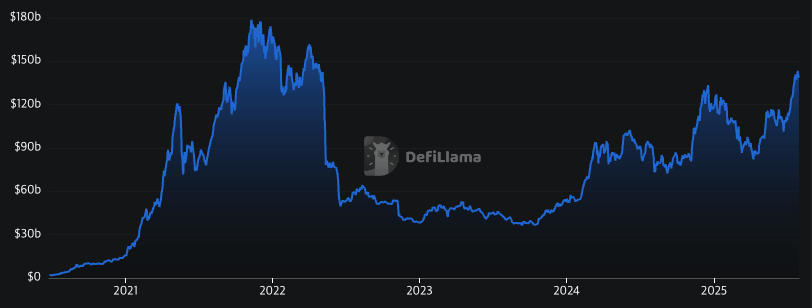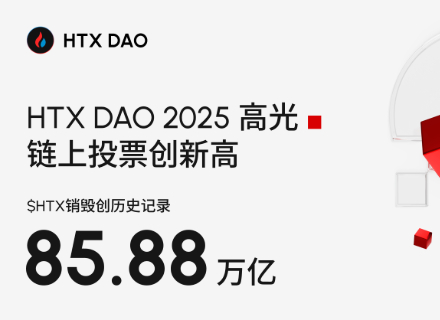DeFi Summer Returns? IMF Embraces Crypto and More
DeFi's TVL returns to pre-Terra levels, the IMF acknowledges cryptocurrencies in national wealth accounts, and Visa broadens stablecoin support as institutional adoption grows.
Welcome to the Asia Pacific Morning Brief—your essential digest of overnight crypto developments shaping regional markets and global sentiment. Grab a green tea and watch this space.
DeFi TVL hits pre-Terra levels while IMF formally recognizes crypto in national accounts. Visa expands stablecoin support across multiple blockchains as institutional adoption accelerates amid growing regulatory clarity worldwide.
DeFi Summer Back? TVL Hits Pre-Terra Levels
DeFi total value locked reached $138 billion, matching pre-Terra collapse highs. The sector briefly exceeded $140 billion during the July 28-30 trading sessions. This marks the highest TVL since May 2022’s UST-LUNA crisis.
 DeFi total value locked reached $138 billion, matching pre-Terra collapse highs. Source:
DefiLlama
DeFi total value locked reached $138 billion, matching pre-Terra collapse highs. Source:
DefiLlama
Lending and staking services drove the recovery across major protocols. AAVE leads with $34.405 billion in locked assets for lending operations. Lido follows closely at $33.619 billion in liquid staking services.
EigenLayer rounds out top three with $18.029 billion in restaking protocols. Whether this signals a sustained DeFi revival remains uncertain. Market observers question if momentum can surpass 2020’s original summer.
IMF Embraces Crypto in National Accounts
The International Monetary Fund softened its stance on digital assets this week. Global regulators updated national wealth measurement standards to include Bitcoin and cryptocurrencies. The revised System of National Accounts now classifies crypto as “non-produced nonfinancial assets.”
Countries will report crypto holdings on national balance sheets starting 2029-30. These assets remain excluded from GDP calculations but gain formal recognition. The change reflects growing adoption and potential financial stability implications.
El Salvador benefits significantly from this policy shift amid ongoing IMF negotiations. The country’s 6,000+ Bitcoin holdings will now appear in official wealth statistics. This development marks a pragmatic turn in institutional acceptance of digital assets.
The framework modernizes economic data collection for the digital age. New guidelines also cover artificial intelligence, cloud services, and digital platforms. Regulators aim to balance financial innovation with systemic stability concerns.
Visa Expands Stablecoin Support Across Multiple Blockchains
Visa added PayPal’s PYUSD, euro-backed EURC, and Global Dollar to its platform. The payment giant now supports Stellar and Avalanche blockchain networks. Users can send payments or convert stablecoins to fiat currency.
The expansion builds on existing USDC support across Ethereum and Solana. Visa has processed over $225 million in stablecoin volume since 2023. Institutional interest surged following the passage of the GENIUS stablecoin bill.
Mastercard reports 30% of transactions are already tokenized through crypto partnerships. JPMorgan and Bank of America are developing similar stablecoin infrastructure. Amazon and Walmart explore issuing proprietary stablecoins for cross-border payments.
The $256 billion stablecoin market attracts traditional finance and tech giants. Visa’s May investment in BVNK signals deeper crypto infrastructure commitment. Cross-border transactions remain expensive through legacy payment networks.
Disclaimer: The content of this article solely reflects the author's opinion and does not represent the platform in any capacity. This article is not intended to serve as a reference for making investment decisions.
You may also like
SOL drops to 5-month low despite Solana spot ETF success: Is $100 next?

Major Overhaul in US Crypto Regulation: CFTC May Fully Take Over the Spot Market
The US crypto regulatory framework is undergoing a redistribution of authority, with clear divisions of responsibility between the CFTC and SEC: the SEC focuses on securities, while the CFTC is responsible for the spot market of digital commodities. The advancement of new bills and the arrangement of hearings indicate that the regulatory boundaries have been formally clarified in official documents for the first time. Summary generated by Mars AI. This summary is generated by the Mars AI model, and the accuracy and completeness of its content are still being iteratively updated.

Oil price rebound alert! Russia's largest oil port attacked, 2% of global supply disrupted
A Ukrainian drone attack has caused the suspension of oil exports at Russia's Novorossiysk port, interrupting a daily supply of 2.2 million barrels. As a result, international oil prices surged by over 2%.

When traditional financial markets fail, will the crypto industry become a "pressure relief valve" for liquidity?
The twilight of financialization: when debt cycles can only create nominal growth.

